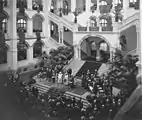Tropenmuseum
The Tropenmuseum (English: Museum of the Tropics) is an ethnographic museum located in Amsterdam, Netherlands, founded in 1864.[1]
 The Tropenmuseum in 2016 | |
 Location of the museum in Amsterdam | |
Former name | Koloniaal Museum (Colonial Museum) |
|---|---|
| Established | 1864 |
| Location | Linnaeusstraat 2, Amsterdam, Netherlands |
| Coordinates | 52.362692°N 4.922517°E |
| Type | Anthropological museum |
| Collection size | 340,000 objects and photographs |
| Visitors | 197,000 visitors (2010) |
| Founder | Frederick van Eeden |
| Director | Wayne Modest & Marieke van Bommel |
| Public transit access | Alexanderplein GVB tram lines 9, 10, 14 |
| Website | tropenmuseum.nl |
One of the largest museums in Amsterdam, the museum accommodates eight permanent exhibitions and an ongoing series of temporary exhibitions, including modern and traditional visual arts and photographic works. The Tropenmuseum is part of the Nationaal Museum van Wereldculturen (Museum of World Cultures), a combination of three ethnographic museums in the Netherlands.[2]
History
Frederick van Eeden, father of the writer Frederik van Eeden, and secretary of the Maatschappij ter bevordering van Nijverheid (English: Society for the Promotion of Industry) established the Koloniaal Museum (English: Colonial Museum) in Haarlem in 1864,[1] and opened the museum to the public in 1871.[3] The museum was founded in order to show Dutch overseas possessions, and the inhabitants of these foreign countries, such as Indonesia. In 1871 the institute began research to increase profits made off the colonies. This included attempting to develop improved means of producing coffee beans, rotan and paraffin. The museum came under the influence of ethnologists, who added information on the economy, manners, and customs of the inhabitants. In 1926, they inaugurated the current building in East Amsterdam. At the time, they had 30,000 objects, and a sizable collection of photographs.[3]
Following the independence of Indonesia in 1945, the scope of the museum changed from just the colonial possessions of the Netherlands, to that of many undeveloped colonial states in South America, Africa, and Asia. In the 1960s and 1970s the Dutch Ministry of Foreign Affairs encouraged the museum to expand its scope to more social issues such as poverty and hunger. In the early 1970s a new wing for children was added. This wing is now called Tropenmuseum Junior.[3]
Until March 2014 the museum was owned and operated by the Royal Tropical Institute, a foundation that sponsored the study of tropical cultures around the world. The museum had 176,000 visitors in 2009.[4]
 The opening of the Colonial Institute by Queen Wilhelmina, 1926.
The opening of the Colonial Institute by Queen Wilhelmina, 1926. Interior of the museum.
Interior of the museum. Traditional Javanese illustration of Captain Tack's death during the Trunajaya Rebellion, kept at the Tropenmuseum.
Traditional Javanese illustration of Captain Tack's death during the Trunajaya Rebellion, kept at the Tropenmuseum.
Facility
The original building, built in 1926, was designed by Johannes Jacobus van Nieukerken and Marie Adrianus van Nieukerken. It was richly decorated for the time, and took 11 years to build due to World War I and various labor strikes.[5] All of the artwork in the building was created in the first half of the 20th century. In 2003, the museum was listed as a historical building in Amsterdam.[3]
Collections

The museum houses 175,000 objects, 155,000 photographs and 10,000 miscellaneous drawings, paintings, and documents.[6] It inherited 15,000 of these from the Ethnographisch Museum Artis. These objects are split up into many collections. The museum houses collections for many geographical areas such as Southeast Asia, South Asia, West Asia, North Africa, Sub-Saharan Africa, Latin America and the Caribbean. They also have several collections in storage that fall outside of their scope. These include collections for China, Japan, Korea, and Europe.
The photography collection consists mainly of historical photographs of the former Dutch Colonies from 1855 to 1940. In the period 2009-2015 the Tropemmuseum released 50,000 photographs under a Creative Commons licence to the Wikimedia Commons.[7][8]
A theatric collection is housed at the Tropenmuseum as well. The collection houses 5,500 musical instruments as well as various other theatrical objects such as masks and puppets. It also features 21,000 textile artifacts, a majority of which are from Indonesia. Tropenmuseum Junior is a sub-museum. It features interactive exhibits, and draws 30,000 children a year.[3]
References
- "Tropenmuseum – Tropical Museum Amsterdam". Amsterdam.info (in Dutch). Retrieved January 27, 2010.
- "Fusie volkenkundige musea (2014) - in Dutch". Archived from the original on 2016-01-01. Retrieved 2015-09-14.
- Tropenmuseum. "Tropenmuseum vroeger en vandaag" [Tropenmuseum Past & Present] (in Dutch). Amsterdam: Tropenmuseum. Retrieved 2010-04-11.
- "176.000 bezoekers voor het Tropenmuseum in 2009 – Tropenmuseum". Tropenmuseum. 2010-04-07. Archived from the original on 2011-07-24. Retrieved 2010-04-11.
- "History". Royal Tropical Institute. Archived from the original on 26 March 2010. Retrieved 12 April 2010.
- "Collection". Tropenmuseum in Amsterdam. Retrieved 2022-09-22.
- "Tropenmuseum in collaboration with Wikipedia". Netherlands. 2009-10-21. Retrieved 11 April 2010.
- Wikimedia Commons (11 Sept. 2015): Images from the Tropenmuseum: 49,235 items